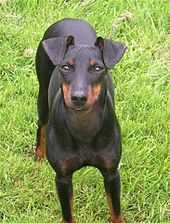Manchester Terrier
 | |||||||||||||
| Manchester Terrier in show pose | |||||||||||||
| Country of origin | England | ||||||||||||
|---|---|---|---|---|---|---|---|---|---|---|---|---|---|
| |||||||||||||
| |||||||||||||
| Dog (Canis lupus familiaris) | |||||||||||||
The Manchester Terrier is a breed of dog of the smooth-haired terrier type.
History
In England
The early 19th century saw times of poor sanitation in England. Rats soon became a health menace and rat killing became a popular sport. John Hulme, enthusiastic devotee of the sport of rat killing and rabbit coursing, crossed a Whippet to a cross bred terrier to produce a tenacious, streamlined animal better suited to the sport. This cross proved so successful that it was repeated, resulting in the establishment of a definite type.
By 1827 the breed's fighting spirit had made it equally handy along a hedge row as in a rat-pit. The Manchester could tackle an opponent twice its size. Ears were cropped to save risk of being torn in frequent scraps. (This also enhanced the sharp appearance of the expression). When rat-killing became illegal in England rat-pits were supplanted by dining halls or public inns, all of which were infested by rats. To combat the rodent problem each inn kept kennels.
By 1860 Manchester was the breed centre for these "Rat Terriers", and so the name Manchester Terrier became established. Smaller specimens began to gain appeal. Some breeders were known to introduce Chihuahuas in order to reduce size to as small as 2½ pounds. This resulted in numerous problems, including apple heads , thinning coats and poppy eyes. Inbreeding further diminished size yet the smaller versions, though delicate and sickly, remained popular for some time.
Smaller Manchesters were carried in specially designed leather pouches suspended from the rider's belt, (earning the title of "Groom's Pocket Piece"). With their smaller stature these dogs obviously could not keep up with the hounds, but when the hounds ran the fox into dense thickets they were not able to penetrate, the little Manchester Terrier was released. The breed was nicknamed the "Gentleman's Terrier".
More information about Manchester Terriers in England and the history can be found on this website Manchester Terriers
In the United States
As in its native country the Manchester gained quick acceptance as a recognised breed. In 1886, just two years after the American Kennel Club was organized, the first Black and Tan Terrier was registered in the stud book. The following year "Lever" (AKC #7585) became the first AKC recognised Manchester Terrier.
The 20th century is dotted by the recognition of breed clubs devoted to preserving and promoting this breed:
In 1923 the "Manchester Terrier Club of America" was recognised and 1934 saw the Toy Black and Tan Terrier changed to Toy Manchester Terrier, and in 1938 the "American Toy Manchester Terrier Club" was recognised.
By 1952, however, the "Manchester Terrier Club of America" (Standards) was without organised breed representation. To the credit of the "American Toy Manchester Terrier Club", the two breeds were combined as one (with two varieties - Standard and Toy) with the formation of the "American Manchester Terrier Club" in 1958, an organisation which still survives today.
Description

Manchester Terriers are considered by most to be the oldest of all identifiable terrier breeds, finding mention in works dating from as early as the 16th century. In 1570 Dr. Caius (Encyclopedia of Dogs) gives mention to the 'Black and Tan Terrier,' though he referred to a rougher coated, shorter legged dog than we are now accustomed to.
By the early 19th century, a closer facsimile to the current Manchester Terrier had evolved. In The Dog in Health and Disease by J. A. Walsh, a full chapter was devoted to the Black and Tan, for the first time recognising it as an established breed. The description given by Walsh is still relevant: Smooth haired, long tapering nose, narrow flat skull, eyes small and bright, chest rather deep than wide, only true colour black and tan.
This breed has maintained consistency in type and appearance for nearly two centuries (at the very least).
Varieties

In its native England, The Kennel Club recognises the Manchester Terrier in the Terrier Group and the closely related English Toy Terrier (Black and Tan) in the Toy Group.
In North America the Manchester Terrier is divided into two varieties. The Toy Manchester Terrier was originally recognised as a separate breed in 1938, bred down in size from the Manchester Terrier. The Toy Manchester Terrier weighs less than 12 lb (5.4 kg) and has naturally erect ears, never cropped. It is placed in the Toy Group by the Canadian Kennel Club and the American Kennel Club, although the Manchester Terrier is placed in the Terrier Group. The Manchester Terrier non-toy variety weighs 12 to 22 lb (5.4 to 10.0 kg) and has three allowable ear types (naturally erect, button, or cropped). Other than size differences and ear type, the Manchester Terrier and the Toy Manchester Terrier have the same over all appearance, and since 1958 have been varieties of the same breed.
Health
The Manchester Terrier has a median lifespan of around 12.8 years and the Toy variety 12.0 years.[1] Through good breeding and a strong blood line the average Manchester Terrier has a life span of 18 years, there have been some dogs known to reach 24 years.
See also
- Rat-baiting
- English Toy Terrier (Black and Tan)
References
External links
| Wikimedia Commons has media related to Manchester Terrier. |
- Manchester Terrier breed standard at the official American Kennel Club website
- Manchester Terrier on the Open Directory Project
- Manchester Terrier a breeder and fan page
| |||||||||||||||||